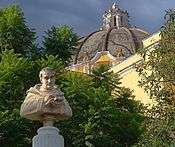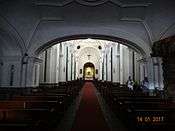Iglesia de La Merced, Antigua Guatemala
| Convent of the Mercedarians | |
|---|---|
|
Iglesia y convento de Nuestra Señora de Las Mercedes Convento e Iglesia de La Merced (Spanish) | |
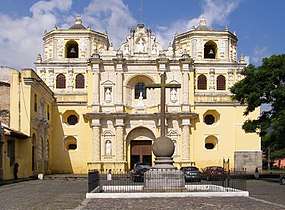 Main facade | |
|
Location in Antigua Guatemala | |
| General information | |
| Status | Active church |
| Architectural style | Spanish seismic baroque |
| Location |
Antigua Guatemala, |
| Coordinates | 14°33′42.016″N 90°44′3.649″W / 14.56167111°N 90.73434694°WCoordinates: 14°33′42.016″N 90°44′3.649″W / 14.56167111°N 90.73434694°W |
| Construction started | 1751 |
| Completed | 1767 |
| Destroyed | |
| Owner | Secular clergy |
| Design and construction | |
| Architect | Juan de Dios Estrada |
La Merced Church is a baroque church in Antigua Guatemala, Guatemala.
History
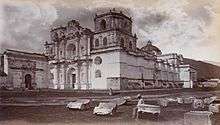
The Mercedarians were the first to establish a male monastery at the former Santiago de Guatemala.[1] The cross in stone at the atrium and the rooms behind the main altar are the oldest structures in La Merced and date from the seventeenth century. In 1749 Juan de Dios Estrada was commissioned with the construction of the luxurious sanctuary and cloister. He erected a building of low height designed to withstand earthquakes based on the experiences of the tremor of 1751. Arches and columns are wider to cope with the quakes. It was opened in 1767.
The effigy of Jesus Christ holding the cross was carved in 1650 by Alonzo de la Paz y Toledo.
Forced translation to the new capital
After the Santa Marta earthquakes in 1773 and against strong opposition from the archbishop and the regular clergy, the capital was moved from Santiago de los Caballeros de Guatemala to a new location, known as Nueva Guatemala de la Asunción. In order to enforce the move, Captain General Martín de Mayorga, decided to force the priests and friars to move the most important religious sculptures to the new city; therefore, in 1778 La Merced friars were forced to move the sculptus of Jesús Nazareno and Virgen Mary to the new city. The move was harsh, as the natives that were supposed to take care of the beloved images arrived late, while the neighborhood was praying and crying while waiting for them. When the sculptures were packaged in a box, their followers walked alonsige them to the Animas gate of the city, and one of them carried the cross of the sculpture all the way to San Lucas Sacatepéquez, a settlement located 15 km away from Antigua Guatemala.[2] The caravan arrived into the new capital at night, and the sculptures were received by Franciscan friars and then by Mercedarians who placed it in a temporary wooden structure located where they were going to build their new church. Martín de Mayorga came to verify the arrival, which signaled the end of the arduous move.[3] In 1801, the fellowship of Jesús Nazareno de la Merced moved the sculpture altar to the new capital even though the new church had not been constructed yet.
But the church -known then as "Oratorio de La Merced"- had not suffered major damage after the earthquake and was still open to the public; it kept its treasures and altars until 1813, when the new capital's church was opened. Still, even when all the sculptures and altars moved to the new city, the old church remained open.[4] Finally, in the mid 19th century San Sebastián parish moved to this church and it has been there since.[4]
Description
The facade in barroque style is flanked by two bell towers of low height. On top looms the effigy of San Pedro Nolasco who foundend the Order of the Blessed Virgin Mary of Mercy in the thirteenth century. He is flanked by two Mercedaries and the crest of the order. The effigy of Our Lady of Mercedes is situated in the central niche of the facade. She is flanked to the left by the effigies of San Raymundo Nonnatus and San Pedro Arinengol (with a rope indicating his martyrdom because of being hanged) and to the right side by the Mercedary bishop San Pedro Pascual as well as the first Mercedary nun, Santa Maria de Cervellón.
Holy Week
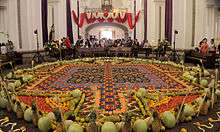
Holy Week processions are one of the top tourist attractions in Antigua Guatemala. From La Merced, two iconic processions make their way thru the streets during Holy Week:
| Day | Sculpture | Hours |
|---|---|---|
| Palm Sunday | Jesús Nazareno de la Reseña | 11:00 am – 11:00 pm |
| Good Friday | Jesús Nazareno de la Penitencia | 4:00 am – 3:00 pm |
Image gallery
See also
Notes and references
References
- ↑ La Merced, Antigua Guatemala
- ↑ Melchor Toledo 2011, p. 151.
- ↑ Melchor Toledo 2011, p. 152.
- 1 2 Melchor Toledo 2011, p. 189.
Bibliography
- ACAN-EFE. "Lanzarán en Guatemala ruta en memoria del Santo Hermano Pedro". Prensa Libre (in Spanish). Archived from the original on 28 November 2014. Retrieved 16 November 2014.
- Castro Seoane, José (1944). "La expansión de la Merced en la América colonial". Missionalia hispánica (in Spanish). Retrieved 24 December 2014.
- EFE Verde. "El Gobierno guatemalteco anunció hoy que lanzará una ruta turística conmemorativa de la canonización del Santo Hermano Pedro de San José de Betancur, celebrada el 30 de julio de 2002 en Guatemala por el papa Juan Pablo II". La Información (in Spanish). Archived from the original on 29 November 2014. Retrieved 16 November 2014.
- La Merced (2013). "La Merced, Antigua Guatemala". La Merced de Antigua (in Spanish). Guatemala. Archived from the original on 5 September 2013. Retrieved 25 September 2013.
- Melchor Toledo, Johann Estuardo (2011). El arte religioso de la Antigua Guatemala, 1773-1821; crónica de la emigración de sus imágenes (PDF). tesis doctoral en Historia del Arte (in Spanish). México, D.F.: Universidad Nacional Autónoma de México. Archived from the original (PDF) on 17 December 2014. Retrieved 10 November 2014.
- Moncada Maya, J. Omar (2003). En torno a la destrucción de la Ciudad de Guatemala, 1773. Una carta del Ingeniero Militar Antonio Marín. Biblio 3W. Revista Bibliográfica de Geografía y Ciencias Sociales (in Spanish). VIII. Barcelona: Universidad de Barcelona. ISSN 1138-9796. Retrieved 28 February 2010.
- Nolasco Pérez, Pedro (1923). Religiosos de la Merced que pasaron a la América Española...: con documentos del Archivo general de Indias. Biblioteca colonial americana (in Spanish). Centro Oficial de Estudios Americanistas de Sevilla, Tipografía Zarzuela.
External links

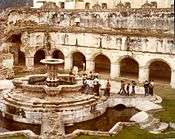
.jpg)
